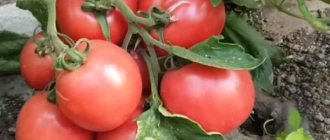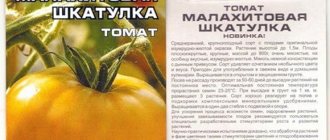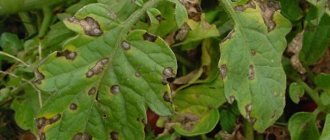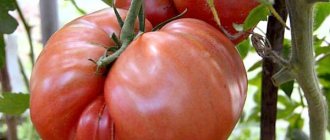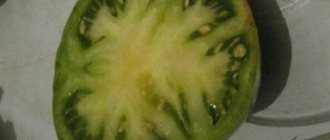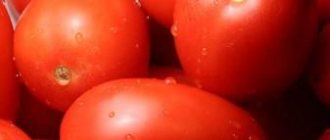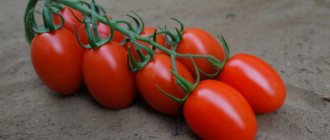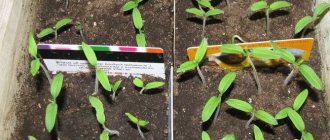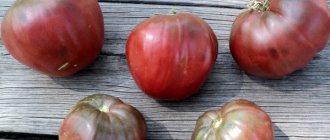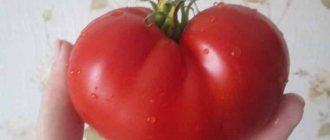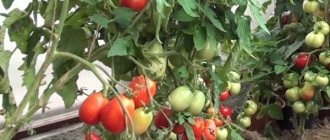The tomato is capable of captivating any gardener, apparently or invisibly by its appearance. This is a low ornamental shrub strewn with bright pink or red fruits. Ripe tomatoes are ideal for both summer salads and winter preparations. This variety is perfect for those who do not want or do not have time to pay much attention to their summer cottage.
The tomato is so easy to care for that even a beginner who prefers easy chores at the dacha to daily battles for the harvest can cope with its agricultural technology.
Characteristics and description of the variety
The creators of the Visibly Invisible tomato set the main goal of obtaining a variety that can be grown in open ground without much effort. Many years of work have been crowned with success - the tomato is not only adapted to open ground, but also shows decent results in greenhouse conditions.
A group of scientists from Siberia worked on the creation of culture. In 2001, the tomato was included in the State Register of Breeding Achievements. The official seed distributor is .
Reference ! “Siberian Garden” is known for the production of seed material of varieties mainly from the Siberian collection.
Distinctive features
Determinate type, no more than 1 m high, standard. The foliage is dense, the leaves are medium-sized, deep green. The first fruitful branch is laid above the fourth leaf, the second - above the sixth, the subsequent ones through one leaf. There are no more than 4-5 fruitful branches in total. When the last flower cluster is formed, the growth of the main stem stops.
Reference ! The standard bush has a thick, stable stem and, due to its lush crown, resembles a miniature tree.
Early ripening variety - 90–100 days pass from the moment of germination to full ripening. Fruiting is extended, vegetables are harvested from early summer to mid-autumn.
Productivity is high, from 1 sq. m, 9–12 kg of fruits are collected, planting no more than three seedlings per 1 sq. m. m.
Disease resistance is good; the crop resists known diseases of the Solanaceae family.
Fruit characteristics
Average weight 100–130 g, traditional, round shape. The color ranges from bright pink to deep red, the taste is sweet with pronounced sourness, which is excellent for pickles and marinades. The strong peel prevents ripe tomatoes from cracking either during the ripening process or in jars. Tomatoes are used to prepare canned juices, adjika, pasta, lecho and sauces. They are also ideal in fresh salads and side dishes.
The size of ripe vegetables allows them to be canned whole; they retain their flavor when pickled.
Thanks to their dense pulp and durable skin, ripe vegetables can withstand long-term storage, maintaining their presentation. They can be transported to any distance without any problems.
The photo shows the Visibly Invisible tomato variety.
Tomato Visibly-invisibly: characteristics, photos, variety yield
As a rule, the names of varieties of tomatoes and other vegetables immediately hint at the main positive quality of this variety.
The tomato variety Apparently Invisibly has an unprecedentedly abundant yield, so vegetable growers should try growing this variety in their beds. And from these vegetables you can collect seed material for subsequent planting.
The main characteristics, agricultural technology of cultivation, pros and cons of the Visibly-Invisibly variety will be discussed in this article.
The content of the article:
1. Visible and invisible: characteristics and description
2. Agrotechnics of cultivation
3. Advantages and disadvantages
4. Tomato Visibly and invisibly: reviews from gardeners
5. Description and characteristics from the tomato manufacturer
How to grow seedlings
Sowing begins eight weeks before planting seedlings in the ground. The culture does not belong to the hybrid type, which means that the seed material can be collected independently. Seeds of varietal crops retain their parental properties in subsequent generations.
Reference ! Seedlings grown from their own seed material have stronger immunity. This is due to the fact that the tomato from which the seeds were collected grew in that region and therefore it is more adapted to that climate.
Seed preparation
Seed preparation is as follows:
- Identification of defective specimens. The seed material is carefully inspected for visible defects.
- Definition of empty seeds. The grains are placed in the saline solution for 10 minutes. Those that float to the surface are disposed of. A saline solution is prepared from 1 teaspoon of salt dissolved in a glass of warm water.
- Disinfection . Seeds are placed in a pink solution of potassium permanganate for 20 minutes. It is prepared from 1 g of manganese dissolved in half a glass of water. After disinfection, the grains are washed and dried.
To increase germination, seed material is soaked in a growth stimulator, for example: “Zircon” or “Epin”. Melt water can also be used for this purpose. Exposure to stimulants - at least 10 hours.
Container and soil
The soil is made from garden soil, peat and river sand in equal quantities. After thoroughly mixing all the components, the resulting mixture is poured with a hot solution of manganese to destroy pathogenic flora. For soil fertility, add a little wood ash.
Containers for sowing are treated with a strong solution of manganese and holes are made at the bottom of each to drain excess moisture. Such holes are necessary, since excess moisture has a detrimental effect on seedlings. Excess moisture promotes root rot and the development of fungal infections.
You can plant in a common wooden box and in separate containers, for example, plastic cups, peat pots, paper honeycombs.
Sowing
The grains are sown to a depth of 1.5 cm, leaving a distance of at least 2 cm between them. Sprinkle with earth on top and lightly moisten with warm, settled water. The seeded containers are covered with film or glass to simulate greenhouse conditions. Until the first shoots, the containers are left in a bright room with a temperature of 24-26°C.
Seedling care
After the seedlings emerge, the containers are placed in a more illuminated place on the windowsill. Getting the required amount of light is important at the initial stage, otherwise the seedlings will stretch and weaken. Daylight hours are 13 hours. If there is a lack of natural light, artificial lamps are installed.
The seedlings are watered with warm, settled water when the soil begins to dry out. Getting moisture is as necessary as getting light. But you should not flood the sprouts; excess moisture will negatively affect the further development of the seedlings.
After watering, the soil is carefully loosened so as not to disturb the young roots. Loosening promotes better penetration of oxygen into the soil.
As soon as the second true leaf is formed, the seedlings are picked and planted in a separate container. Before picking, the soil is well moistened in order to replant along with a lump of earth. With this method of transplantation, young bushes will take root faster. After picking, an increased growth of lateral roots occurs, due to which the seedlings develop more intensively.
During the seedling period, young bushes are fed twice. The first fertilizing is carried out a week after picking, the second time the seedlings are fertilized before planting in a permanent place. Feed with liquid fertilizer for tomato seedlings. All fertilizing is combined with watering.
Two weeks before planting, the seedlings are hardened off in the open air. The seedlings are taken outside in the daytime at a temperature of 16°C. The night temperature in the room is reduced to 12°C.
Rules for planting and growing
Tomatoes are apparently grown in seedlings. Seeds can be purchased or prepared independently (in this case, before planting, they are treated with potassium permanganate and treated with a growth stimulant, for example, aloe juice).
Growing seedlings
It is advisable to sow seeds for seedlings in mid-March - early April. Sliding containers or peat cups are best suited for containers.
Special containers make the process of growing seedlings easier
The selected container is filled with soil (chernozem with humus or purchased soil), moistened and the seeds are planted to a depth of 1–1.5 cm in increments of 5–6 cm. The seeded containers are covered with polyethylene and put away in a warm, dark room. A week later, when the sprouts appear, you need to remove the film and place the seedlings in a bright room. The required temperature during the day is 22…26 °C, at night 17…18 °C. For normal development, at least 12–14 hours of lighting per day are required, so additional illumination with a phytolamp may be necessary.
The phytolamp creates the spectrum necessary for plant development
It is necessary to water the seedlings when the soil dries out (every 4–5 days) with non-cold water. It is not necessary to feed seedlings with normal development, but with weak growth, Nitrophoska solution will help.
After the appearance of the 2nd true leaf, the plants are planted in a 0.5 liter container.
Picking tomatoes - video
Tomatoes are permanently planted and transferred approximately 50–60 days after germination. Before transplanting, plants should be hardened off by taking them outside.
How to care for tomato plantings
Tomatoes are planted in beds prepared in advance (cleared of weeds, fertilized with humus).
Recent Entries
5 working ways to use tar in the garden 7 indoor plants that help you get married even in adulthood Indoor plants that can bloom in trouble
The predecessors of tomatoes should be carrots, cabbage, green onions, garlic, and herbs.
Planting follows the same rules as for other varieties. Planting density for tomatoes Apparently, 3 bushes per 1 square meter are recommended .
The variety is demanding when it comes to watering, so water must be supplied regularly according to the following scheme:
- Before flowering, weekly watering is required at the rate of 3.5–4 liters per bush;
- with the beginning of the formation of ovaries, water must be supplied 2 times a week, 3–3.5 liters per bush;
- As soon as the fruits begin to fill, you should return to the original water supply mode.
After precipitation or watering, you need to loosen the soil (depth 5–6 cm) and add minerals. To retain moisture, it is better to mulch the soil with mowed grass.
Fertilizing is very important for the variety. Before flowering, it is recommended to water with mullein, and from the beginning of flowering - with phosphorus and potassium fertilizers (30 g of potassium sulfate and superphosphate per bucket of water). During cold weather, tomatoes need to be supported by foliar treatments with solutions of mineral fertilizers (Sortolin, Kristalon). You can use nettle infusion with the addition of ash or yeast.
Since the growth of the main stem stops after the formation of four fruit clusters, the bushes must be grown in several stems (from 2 to 4). Apparently, invisibly, it forms a lot of stepsons and the extra ones need to be removed every week . Due to the high yield, the stems can break, so tomatoes need supports (wooden stakes, metal rods).
To prevent the stem from breaking, it must be tied to a peg.
In my opinion, the most important thing when growing tomatoes is good care. During the summer, 2–3 times (after watering) I hill up the bushes to a stem height of 10–12 cm. To reduce the number of weedings and loosening, I regularly cover the soil with mulch (ash, vegetable peelings, used tea leaves are suitable). Mulching with nettles will help get rid of aphids and slugs at the same time. You need to constantly remember about feeding. I feed my tomatoes 3 times - the first time with urea and nitrophoska (a tablespoon per bucket of water), and then with complex fertilizers. If the weather is cloudy, you need to give the plants more potassium, and in sunny weather - urea. Tomatoes that are lagging in growth are well “encouraged” by spraying with urea (20 g per bucket of water).
How to grow tomatoes
The seedlings are transplanted as soon as the soil warms up to 16-17°C. In case of return of frosts, always keep covering material ready.
Landing
The holes are made in advance, no deeper than 15 cm. A little wood water is placed at the bottom of each and filled with warm water.
Replant on a cloudy day or after sunset. The distance between seedlings is 40 cm, between rows - 70 cm. Per 1 sq. m place no more than three plants.
After transplantation, the holes are compacted, watered with warm, settled water and the seedlings are left to get used to the new conditions for a week.
Further care for tomato Visible and invisible
For full growth and development, tomatoes need systematic watering, weeding and lighting. To prevent the bushes from shading each other, they are planted in a checkerboard pattern. With this method of planting, they not only receive a sufficient amount of light, but are also ventilated as needed. Ventilation prevents fungal infections from developing.
Water moderately, no more than twice a week. To retain moisture in the beds, they are mulched with straw or dry leaves. When mulching with weeds, additional nutrition is supplied to the roots, since when the weeds rot, they release a lot of nutrients.
Loosening the beds improves the breathability of the soil, saturating the root system with oxygen. With constant access of oxygen to the roots, plants develop fully.
Fertilizers include a complex of minerals or organic matter. Fertilize 3-4 times throughout the season. For the first time, nitrogenous fertilizers are applied in open ground two weeks after transplantation. During the formation of ovaries and fruiting, they are fed with phosphorus and potassium.
Organic matter, mullein infusion or bird droppings are also used in a ratio of 1:15. The application of organic matter is alternated with mineral fertilizing.
Reference! All fertilizing is applied immediately after watering.
Features of care and possible difficulties
As a rule, low-growing bushes are not planted, thereby increasing their yield. But judging by the characteristics and reviews, it is possible to increase the output of the Visibly Invisible tomato variety when forming plants. The main growth point is transferred to the most powerful of the lower stepsons; the formation of the bush will depend on this. Usually the plant is grown in two or three stems.
From the photo and description you can see that the branches are literally strewn with ripe vegetables. No matter how powerful the trunk is, it will not support so many fruits. The branches will begin to spread along the ground, and the vegetables will rot upon contact with the ground. Therefore, they are tied to an additional support installed next to each seedling.
Diseases and pests
The crop is immune to the main tomato diseases, but when the plantings are dense, there is a threat of late blight. For preventative purposes, remove all lower leaves up to the first fruiting cluster, as well as all yellowed foliage.
When spraying plants with fungicidal agents, the risk of infections in greenhouses is reduced. Enclosed structures often experience elevated levels of humidity and temperature. To keep these indicators normal, the greenhouse is ventilated daily.
When planting in a greenhouse, the soil must be spilled with a hot solution of potassium permanganate and copper sulfate . Copper sulfate destroys fungal spores in the soil. The walls of the greenhouse are treated with Bordeaux mixture.
Among the pests, seedlings are attacked by aphids, mole crickets and slugs. A soap solution used to treat plant stems will help against aphids and slugs. It is prepared simply: one piece of laundry soap is dissolved in a bucket of warm water.
The mole cricket moves underground and is difficult to notice. But it is sensitive to odors, so experienced gardeners do not wait for its appearance, but immediately after planting the seedlings, they bury crushed garlic cloves in the beds, which repel the pest from planting.
Interesting ! The mole cricket is a distant evolutionary relative of the grasshopper. It reaches a length of up to 5 cm and spends most of its life underground. Its front legs are powerful digging scoops, with which they disrupt the root system and the plants die.
Peculiarities of growing tomatoes: visible and invisible
Many gardeners attribute the peculiarities of growing tomatoes apparently and invisibly as disadvantages, although it is unlikely that they have much experience in growing other varietal tomatoes that are planted directly with seeds or do not require care in the form of watering and fertilizing.
Sowing
Planting material begins to be prepared, as usual, in the last days of February - the first days of March, two months before planting at a permanent growing site.
- For seedlings, we prepare a mixture of equal parts of soil, sand and peat with the addition of ash. Ash is an excellent disinfectant and natural fertilizer.
- It is necessary to pickle the seeds in a weak solution of potassium permanganate (potassium permanganate) for 15 minutes, rinse and dry. It is advisable to treat the seeds with antifungal agents and insecticides.
- Check the seeds for germination by placing them in a container of water for 5 minutes. Throw away any seeds that have flared up.
- Fill special planting boxes with earthen substrate, make grooves 1.5 cm deep in it, and plant the seeds. After planting, sprinkle with soil and moisten. Cover the boxes with film and place the seedlings in a dark place with temperatures of +20-23°C.
- Within 5-7 days, the first shoots appear, remove the film, and take the seedlings to a lighted place.
- It is necessary to ensure that the seedlings feel comfortable and do not stretch out: temperature +20-23 ° C, watering without excesses, absence of drafts.
Dive
Picking is done when the first two leaves appear on the seedlings.
It is necessary to transplant the seedlings with a lump of earth from a common box into separate pots, ensuring the safety of the roots. It is good to mulch the soil around the stem and water it.
During the period of development and growth of seedlings, it is necessary to feed it twice with complex additives for tomatoes.
Transfer
Seedlings are planted in a permanent location in May, provided the soil temperature at the depth of the palm is +15-16°C. For areas with a cool climate and the possibility of late frosts, it is better to choose greenhouses, or at least cover the planted plants with film. In the southern regions, tomato thrives in unprotected soil.
Planting is done according to the 30-40*70 pattern. 4 bushes are planted per 1 m2. Do not bury the roots deeply, given the small growth of the entire plant. After planting, water thoroughly and mulch the soil around the stems.
Care
Many care features include watering and fertilizing during the period of active growth of the bush.
- The most significant harvest, according to gardeners, can be grown by forming a bush into one main stem, with the removal of all side shoots, with five tassels.
- In case of large fruiting, strengthen the plants with supports and tying.
- Water abundantly and as needed.
- Apply phosphorus, potassium and nitrogen fertilizers in a timely manner (the latter should be limited to the flowering period).
Ask at gardening stores for complex fertilizers recommended for ripening the fruits of early-ripening tomato varieties.
- Periodically carry out preventive work to protect against diseases and pests.
Nuances for open ground and greenhouses
In open ground, seedlings grow no more than 60 cm, while greenhouse plants reach 1 m. When planted in a greenhouse, more distance is left between seedlings. Otherwise, dense plantings will lead to the spread of fungal infections.
According to the rules of crop rotation, tomatoes are not planted in those beds where peppers, eggplants or potatoes previously grew. These crops belong to the same family and suffer from the same diseases. In addition, after them the soil is depleted and will not be able to ensure the full development of tomatoes.
When planting seedlings in open ground, the beds are chosen in a sunny place and without drafts. Drafts can seriously damage the crop (break the stem or individual branches). The plant will not be able to fully receive nutrition and will die.
Similar varieties
Apparently and invisibly, in terms of characteristics and descriptions of the variety, it is similar to the following varieties of tomatoes:
- Super-klusha is a standard, miniature tomato, the size of the bushes does not exceed 30-40 cm, with a fruit ripening period of 90-95 days. Pink round tomatoes weighing 150-250 g, good taste for early tomatoes. Productivity 10 kg/sq. m. The cultivar has average resistance to pathogens, but manages to complete fruiting before the massive development of diseases.
- Pretty is a determinate tomato for cultivation in any conditions. Pink round tomatoes ripen in 95-105 days. From 1 sq. m, 7-9 kg of crop is harvested with dense planting. The pretty plant is hardy and resistant to major nightshade diseases.
- My family is a variety of amateur selection, determinant, with a bush height of 0.7-0.8 m. In a greenhouse it reaches 1-1.2 m. The ripening period for tomatoes weighing 250-350 g is 100-110 days. Round, slightly ribbed, raspberry-pink tomatoes have sugary flesh and contain few seeds. The yield is high - 2.5-3.5 kg per bush.
Apparently, they differ favorably from similar varieties in their amazing yield, resistance to diseases and adverse weather factors.
Harvesting and application
The harvest does not begin until July. Due to long fruiting, ripe vegetables are harvested before the first frost.
The use of tomatoes is universal. Due to their durable skin and small size, they are excellent for full-fledged canning, pickles and marinades. They are also used for processing into tomato products, preparing ketchups, juices, pastes and adjika.
Fresh vegetables are especially good. They complement any dish and retain their flavor properties in freshly squeezed juices.
Characteristics of the variety
This tomato variety is distinguished by its unpretentiousness and excellent yield. The fruits ripen quickly, grow to relatively large sizes and are universal in use. The tomato is great for growing both in the southern regions and in the north; it just needs some protection.
Productivity
With good watering and bait, you can harvest 3 kg of tomatoes from one bush. It often happens that during the season there are even more fruits, and this takes into account that the bush itself is small in size.
Resistance to diseases and adverse conditions
In terms of disease resistance, the plant has no special features: it is at an average level. Contrary to this, summer residents claim that the crop is rarely exposed to diseases or does not get sick at all.
Application area
Tomatoes Apparently they are often used fresh, because tomatoes look attractive and are not prone to cracking. They are used for various types of preservation, drying and drying. Their sweetish pulp allows this variety to become a tasty addition to many dishes.
Advantages and disadvantages
Tomato has many advantages:
- possibility of breeding in all regions;
- unpretentious care;
- compact and decorative bush;
- resistance to diseases;
- high fruiting rate;
- good taste of fruits;
- numerous ovaries;
- extended fruiting;
- versatility in cooking;
- long-term storage;
- transportation over any distance.
The disadvantages of tomatoes include the garter of low-growing plants.
Reviews from gardeners
Those who have been planting the Visibly-Invisibly variety for several years now are satisfied. They are quite satisfied with the level of harvest and the taste of the fruits, which are used fresh, for preparing salads and other dishes, and for preservation.
The description of the variety attracts many new gardeners, increasing its popularity, but with all the advantages, there are also some disadvantages. Gardeners say that the bush constantly needs shaping. In addition, there are often cases when the result of cultivation did not coincide with the characteristics.
Farmer reviews
Gardeners' opinions about tomatoes are positive, as the result lives up to expectations.
Anna, Nizhny Novgorod: “We have been growing this variety for four years now and have no plans to give it up yet. The name is true - there really are always a lot of tomatoes. Moreover, regardless of the vagaries of the weather, even in a relatively cool summer it did not get sick and produced a decent harvest.”
Victor, Omsk: “I read the reviews and photos and decided to plant Visibly Invisibly tomatoes at my dacha. I liked the compactness of the seedlings and simple agricultural technology. The result is stunning. The vegetables performed well in winter preparations.”
Care
According to the description of the crop, it needs to be provided with decent care in order to harvest a high-quality harvest.
Before flowering, the variety is watered once a week. It should take about 1-2 liters per bush. When the ovary is formed, the plant needs more moisture. Watering is carried out every 4 days with a volume of water of 3-5 liters. Such frequency and fluid consumption are relevant until the fruit is filled, then you can return to the original version.
Watering slightly compacts the soil, so after each time you need to loosen the soil by 5 cm. The main thing here is not to harm the root system.
The soil should be mulched. This is done with humus or straw.
The bush needs pinching every week. It is formed into 1 stem.
The plant must be tied up: to do this, take an ordinary wooden stake, to which the stem is attached with a rope or a piece of fabric.
Feeding is important for the variety. Infusions of urea and mullein are suitable before flowering, because the nitrogen they contain promotes growth. Then phosphorus and potassium solutions will be useful (30 g of dry fertilizer per 10 liters of water).
It is better to spray tomatoes with fertilizer in the mornings or evenings, when it is not so sunny.
():
Feeding with basic nutrients (nitrogen, phosphorus and potassium) is carried out at the root in the form of aqueous solutions. Foliar feeding (spraying on leaves) is carried out with solutions of microelements (iron, copper, boron, calcium, etc.)
Natural fertilizers are welcome. For this, infusions of nettle, wood ash, yeast and bone meal are often used.
Disease and pest control
According to the description, the plant rarely gets sick, but there is a possibility of being affected by late blight, fusarium and brown spot, so it is better to know in advance how to deal with this. Before processing tomatoes, affected leaves must be removed. Only after this can you spray with fungicides (Topaz, Fitosporin). The proportions are indicated in the instructions.
The following pests are dangerous for vegetables: mole crickets, caterpillars, spider mites, etc. They slow down growth and reduce yields, so they are controlled with insecticides (Fitoverm, Fesbecid). Treatment with these drugs is repeated after 2 weeks.
Fungus is a common problem, but it can be easily prevented if you care for your tomatoes properly. The bush needs to be watered on time, avoid waterlogging, weed the weeds and loosen the soil. Do not exclude preventive measures - spraying with fungicides.
Tomato variety “Visibly-invisibly”
HARVEST 2021. TOMATOES VISIBLY INVISIBLE.
Common tomato Visibly-Invisibly. Brief overview, description of characteristics, where to buy seeds
Characteristics of tomatoes
Perhaps for this variety of tomatoes, the description of the tomatoes themselves recedes into the background, because the main thing is their quantity. But the fruits themselves can also be of interest to gardeners, especially since in their description there are also discrepancies between the characteristics that were declared by the manufacturer on the seed packets and the real data provided by those who grew these tomatoes.
The shape of tomatoes of the Visibly Invisibly round variety is not much different from other traditional varieties.
But there are already big discrepancies with the color of ripe fruits: on the packages from the seed manufacturer of this tomato, “Siberian Garden”, they are described as bright pink, and for many gardeners, tomatoes of this variety become pink after ripening. But other gardeners, of whom there are also many and who also grew this variety, have ripened red tomatoes, without any special hints of a pink tint. Moreover, other characteristics of tomatoes, including yield, were the same.
In any case, experts have yet to understand this phenomenon, and perhaps this is the explanation for the fact that this variety is still not included in the State Register. After all, if it has such discrepancies in its characteristics, then it is too early to talk about the stability of the variety. But for ordinary gardeners, the fact remains that by sowing this variety, you can get seeds of both red and pink flowers.
There are also significant discrepancies in the size of the fruit in the manufacturer’s description and the data received from gardeners. The manufacturer claims that tomatoes of this variety are large-fruited, and the average weight of one fruit is 300 grams. But almost everyone who grew these tomatoes agrees that their weight rarely exceeds 100-120 grams. In some isolated cases, people write that the weight of tomatoes reached 200 grams, but no one has yet managed to grow 300-gram tomatoes of this variety.
The pulp of the fruit is quite dense. The tomatoes themselves are smooth, without ribbing. The thickness of the skin is sufficient so that the tomatoes do not crack either on the bush or in jars.
In terms of taste, they deserve a good rating, but they fall a little short of excellent taste. According to many comments, this variety is excellent for all kinds of preparations. It produces delicious tomato juice, as well as a variety of sauces, adjika and lecho.
They are stored well, but it is better not to delay it. After all, tomatoes take a long time to ripen, so you can always have time to make preparations, and after a while harvest a new crop from the same bushes.
